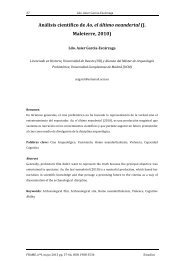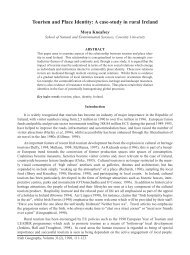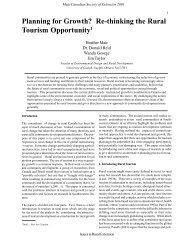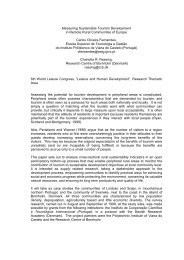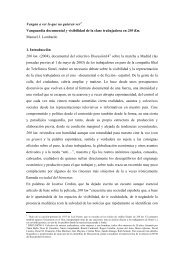Alicante Step by step - Universidad de Sevilla
Alicante Step by step - Universidad de Sevilla
Alicante Step by step - Universidad de Sevilla
You also want an ePaper? Increase the reach of your titles
YUMPU automatically turns print PDFs into web optimized ePapers that Google loves.
EXCURSIONS<br />
ALONG THE COAST:<br />
A resort called Benidorm 42 km north of <strong>Alicante</strong>.<br />
The top tourist resort along the Spanish Mediterranean. Everything here spells leisure, fun,<br />
entertainment. Superb beaches called Levante and Poniente, plus an island in the bay that<br />
looks like a sunken ship and is a must for all visitors to this bustling fun-and-sun capital.<br />
Youngsters and adults, from home and abroad, all enjoy the limitless holiday possibilities<br />
in this city, now even more attractive thanks to the new theme park called “Terra Mítica”.<br />
Along the way, don’t forget to stop in the town of La Vila Joiosa and see its pretty, polychrome<br />
houses facing the Amadorio riverbed and the beach.<br />
La Marina 100 km north of <strong>Alicante</strong>.<br />
The northernmost district in the province of <strong>Alicante</strong>, called La Marina, has a charm all of<br />
it own, with towns such as Calpe, nestling un<strong>de</strong>r the sturdy Rock of Ifach, which has become<br />
a symbol of the Costa Blanca; or Benissa, Javea and Dénia, combining the beauty of their<br />
old town centres, their monuments and history, with a range of excellent sandy beaches<br />
plus impressive cliffs and coves around the capes Cabo <strong>de</strong> La Nao and Cabo <strong>de</strong> San Antonio.<br />
The coast here is interesting and changeable, as visitors will notice on their way through<br />
the Mascarat tunnel and the town of Altea, with its whitewashed house-fronts and wrought<br />
iron windows.<br />
Sun and sand, dunes and salt flats 48 km south of <strong>Alicante</strong>.<br />
The southern coast has a series of attractions that make it highly appealing: it is generally<br />
flat, with broad sandy beaches and extensive marsh areas. Santa Pola is famous for its broad<br />
beaches and its salt flats that host thousands of water fowl and especially flamingos that<br />
take refuge here from col<strong>de</strong>r continental climes. Guardamar offers the charm of its sand<br />
dunes flanked <strong>by</strong> a thriving pine forest. The coastal lagoon of La Mata leads to another first-<br />
rate tourist resort area called Torrevieja, which is home to beach-lovers and sun-seekers who<br />
enjoy its beaches and flock to local property estates in and around the area.<br />
INLAND:<br />
The charm of Guadalest 70 km from <strong>Alicante</strong>.<br />
Can a town with less than 200 inhabitants beat all tourist records in becoming the second most visited place<br />
in Spain, hard on the heels of the Prado Museum in Madrid? Does Guadalest rank in first place in the number<br />
of museums per inhabitant – one for every 20 persons? The answer is “yes” on both counts. This small<br />
village, carved out of the rock, offers charming scenery, typical streets that cars have never driven on, and<br />
a recommen<strong>de</strong>d visit to the home of Los Orduña. There is a scenic route to get to Guadalest, too, through<br />
La Nucía, Polop with its fountain of the 221 spouts, and Callosa d’En Sarrià, offering a view of its waterfalls<br />
and swimming holes on the river: Río Algar.<br />
The route of the Castles 82 km from <strong>Alicante</strong>.<br />
Come and visit an admirable succession of medieval fortresses located on strategic hilltops throughout the<br />
region, overlooking historical towns and mountain passes, in the districts known as El Medio and Alto Vinalopó<br />
and the Hoya <strong>de</strong> Castalla. First, stop at Castillo <strong>de</strong> La Mola in Novelda, with its unique triangular tower, then<br />
continue with the restored Castillo <strong>de</strong> Petrer, the Sax castle on a beautiful rocky spire, then the superior<br />
Atalaya (watchtower) in Villena, and farthest inland, Castillo <strong>de</strong> Bañeres, the top of which commands a view<br />
over four different provinces. On your return journey, Castillo <strong>de</strong> Biar has a double wall around it, and Castillo<br />
<strong>de</strong> Castalla offers a curious pentagonal floor plan capped with two towers, one semicircular in shape.<br />
Elx and Orihuela: art and palm trees 59 km from <strong>Alicante</strong>.<br />
The province of <strong>Alicante</strong> exerts an attraction on all who come<br />
here – because of its fun and sun, its sea and mountains,<br />
its irrigated fields and dry lands, its peace and quiet and<br />
the bustling razzmatazz available in and around the city.<br />
Travel round the largest palm tree plantation in Europe, now listed as World Heritage. The town of Elx has<br />
practically one million specimens arrayed in parks that will <strong>de</strong>light the senses, such as the Hort <strong>de</strong> Baix and<br />
the Huerto <strong>de</strong>l Cura with its “Imperial Palm Tree”. Here one can visit the archaeological site of La Alcudia,<br />
where the Iberian bust known as La Dama <strong>de</strong> Elche was found, or the Altamira Palace, the Calahorra fort,<br />
and the Basilica <strong>de</strong> Santa María, where the famous medieval “Mystery Play” is held every year.<br />
Orihuela, with its San Antón palm tree plantation, also has a monumental town centre to offer the visitor.<br />
The Gothic cathedral of El Salvador, with its diocese museum of sacred art, its Gothic churches of Santiago<br />
and Santas Justina and Rufina, its Santo Domingo College – an ancient university in Renaissance and baroque<br />
style –, the Holy Week and Archaeological Museums, and the Home-Museum of the poet Miguel Hernán<strong>de</strong>z.<br />
41



